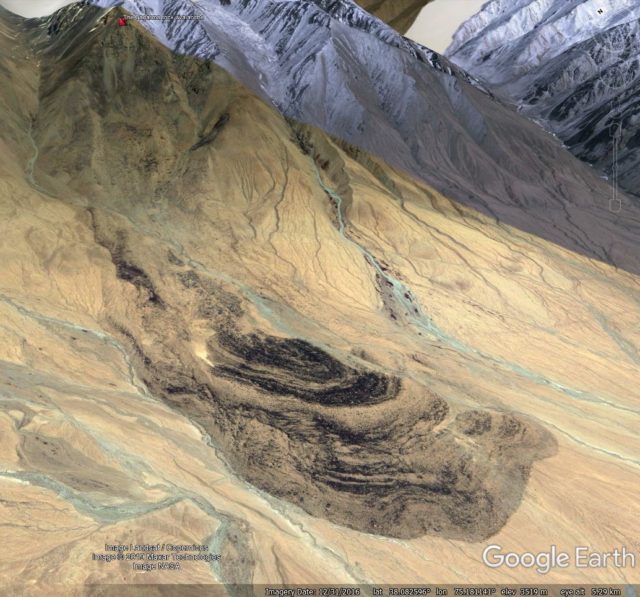5 November 2019
The Tagarma rock avalanche in the Pamir-western Himalayan syntaxis of the Tibetan Plateau
Posted by Dave Petley
The Tagarma rock avalanche in the Pamir-western Himalayan syntaxis of the Tibetan Plateau
The Tagarma rock avalanche is an ancient but beautifully-preserved landslide located on the Tibetan Plateau at 38.081, 75.185. This large landslide has recently been described in a paper (Wang et al. 2019) published in the journal Landslides. This is an interesting landslide in that it is located in the so-called Pamir-western Himalayan syntaxis, a major kink in the tectonic boundary that runs through the Himalayas. As such, this is an area of high seismicity – in 1895 the area was struck by the Mw≈7.0 Tashkorgan earthquake for example. As this is an area of low rainfall, Wang et al. (2019) conclude that this rock avalanche was probably triggered by an ancient earthquake, although the date of this is unknown.
The landslide can be seen in the Google Earth image below:-

A Google Earth image of the Tagarma rock avalanche in Tibet.
.
I have indicated the location of the crown of the landslide with a red marker, whilst the toe of the landslide, in the foreground, can be seen to have some intricate flow type structures. According to Wang et al. (2019), the landslide is 5,430 metres from crown to toe, with a vertical elevation change of 1,510 metres. The estimated volume is 9.6 million m³. These statistics suggest that this was a highly mobile rock avalanche.
As mentioned above, this rock avalanche has complex structures in the landslide deposit. In the dry Tibetan climate these are beautifully preserved:-

Google Earth image of the deposit of the Tagarma rock avalanche in Tibet
.
Based on detailed analysis of the deposit, Wang et al. (2019) suggest that the Tagarma rock avalanche started as a planar slide in the source area, and then transitioned into an extensional slide, in which the front of the landslide moved more rapidly than the rear portion. Lower on the slope, the landslide encountered increased basal resistance, and thus transitioned into a compressive phase that generated the complex structures seen in the deposit. During this phase the landslide also went through some lateral spreading.
Reference
Wang, YF., Cheng, QG., Yuan, YQ. et al. 2019. Emplacement mechanisms of the Tagarma rock avalanche on the Pamir-western Himalayan syntaxis of the Tibetan Plateau, China. Landslides. https://doi.org/10.1007/s10346-019-01298-1


 Dave Petley is the Vice-Chancellor of the University of Hull in the United Kingdom. His blog provides commentary and analysis of landslide events occurring worldwide, including the landslides themselves, latest research, and conferences and meetings.
Dave Petley is the Vice-Chancellor of the University of Hull in the United Kingdom. His blog provides commentary and analysis of landslide events occurring worldwide, including the landslides themselves, latest research, and conferences and meetings.